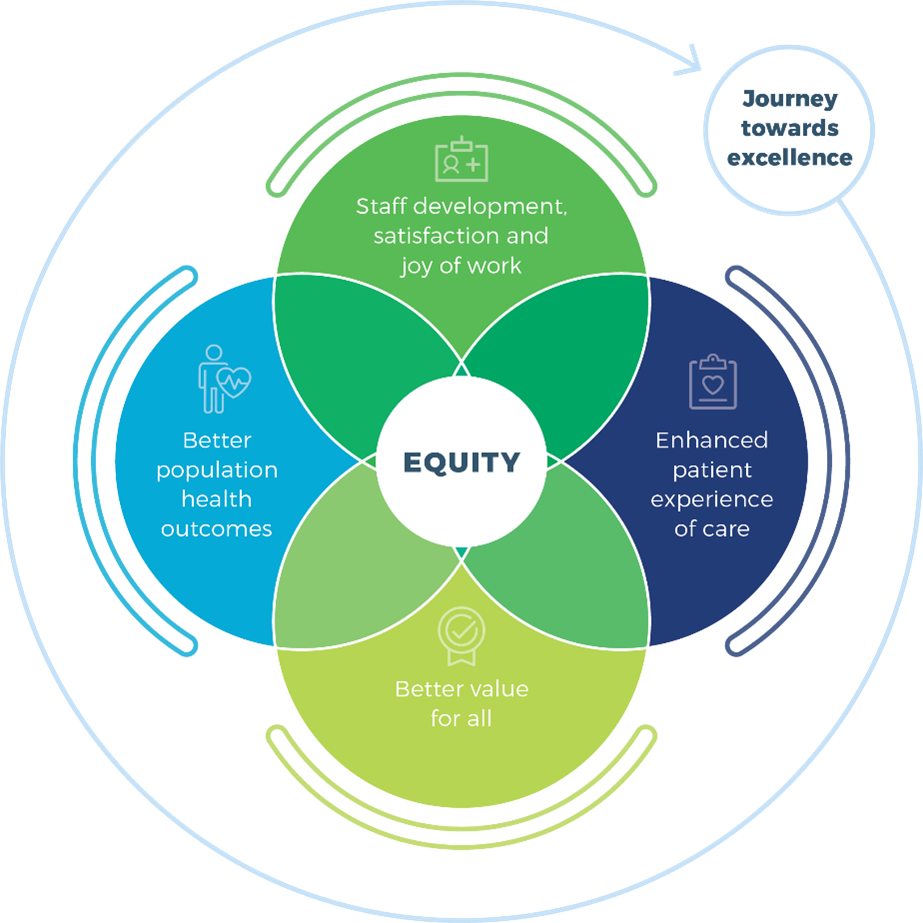Latest news

Part 1: The Quintuple Aim of healthcare | Insights into the RACGP Standards 6th edition
Building Better Practices: Insights into the RACGP Standards 6th edition
PART 1: The Quintuple Aim of healthcare improvement and its role in Australian general practice
Following the release of the draft the Royal Australian College of General Practitioners (RACGP) Standards for general practices 6th edition, industry consultation period and the commencement of the pilot program, our team is excited to provide you with a five-part content series exploring key themes within the proposed new edition of the RACGP Standards titled ‘Building Better Practices: Insights into the RACGP Standards 6th edition’.
Through this series, we aim to provide you with a greater understanding of some of the essential elements shaping the RACGP Standards 6th edition.
In this first instalment, we focus on the Quintuple Aim and its significant role in Australian general practice. Read on as we share practical examples of activities you can implement in your practice that contribute to achieving the five elements of the Quintuple Aim to support improved healthcare outcomes.
DISCLAIMER
The information contained within this content-series is general in nature and has not been provided or reviewed by the RACGP. The RACGP Standards 6th edition are still in draft format and will be undergoing further review and updates as part of the pilot program and consultation period. The details of the 6th edition are subject to change and therefore this information has been collated based on the information provided to us at the time of publishing. Information regarding each proposed new Standard also discusses general themes associated with each particular topic.
The Quintuple Aim of healthcare improvement and its role in Australian general practice
The RACGP Standards for general practices 6th edition draft has been developed using the Quintuple Aim framework, an internationally recognised approach to advancing a sustainable, inclusive and patient-centred healthcare system. Built upon the earlier Triple and Quadruple Aims from the Institute for Healthcare Improvement the Quintuple Aim now integrates health equity as a central focus.

The Five Aims of the Quintuple Aim:
1. Improving patient experience – ensuring patients receive care that is respectful of their needs, values and preferences. These aspects contribute to enhancing patient satisfaction and experience, strengthening trust, communication and engagement between patients and their care providers.
As applied within the RACGP Standards 6th edition:
The 6th edition Standards reflect that patient experience is upfront in the definition of a general practice for the purpose of accreditation, via the inclusion of patient-centred care. The Standards put patients’ needs, values and preferences at the forefront of care to empower them to take an active role in their own healthcare. Criteria related to accessing services, communication with your practice, feedback mechanisms, and practice environment further address patient experience in the Standards.
2. Improving population health – addressing the broader health of populations by actively promoting preventive measures to improve health and well-being within local communities.
This is supported by undertaking activities to provide equitable access to quality care by addressing social determinants of health.
As applied within the RACGP Standards 6th edition:
The 6th edition Standards promote preventive care and access to evidence-based services, advocating the use of primary care in communities. A digital and data-based approach to collecting health information as reflected in the Standards helps practices to understand and manage the health of your practice’s community, as well as informing continuous quality improvement. Criteria related to health promotion and preventative care and environmental sustainability further address population health in the Standards.
3. Reducing per capita healthcare costs – focusing on cost-efficient, safe and quality-focused care reduces unnecessary expenses, making healthcare more accessible, affordable and sustainable. Healthcare organisations are encouraged to identify areas of inefficiency, optimise allocation of resources and reduce waste.
As applied within the RACGP Standards 6th edition:
The 6th edition Standards facilitate a reduction of costs in primary care by encouraging general practices to continuously improve, identify inefficiencies, reduce waste, and effectively allocate resources. By promoting and facilitating uptake of general practice, the Standards help to lessen the burden on the broader healthcare system. The resulting cost savings can be reinvested to enhance patient care and outcomes.
4. Enhancing clinician and health worker well-being – supporting the mental and physical health of healthcare providers to prevent burnout, promoting a strong commitment to high-quality care. When healthcare workers are supported, and their well-being is prioritised, they are more likely to exhibit a greater commitment to the provision of patient-centred care.
As applied within the RACGP Standards 6th edition:
The 6th edition Standards promote care team wellbeing throughout themes of collaboration and communication, patient care and safety, efficiency and productivity, training and continued professional development. The Standards have practices encourage involvement and input from all members of your practice team and foster a positive culture by supporting their safety, health, and wellbeing. Induction, training and development are ways care team wellbeing is further addressed in the Standards.
5. Advancing health equity – promoting fairness and eliminating disparities in health outcomes by fostering a collaborative and inclusive team-based approach to care. This is especially important when caring for marginalised and underserved populations where the need for more comprehensive and tailored healthcare plans may be required.
The 6th edition Standards promote equitable healthcare through the provision of culturally sensitive care, continued quality improvement principles, promotion of accessible healthcare and optimal management of patient health data. The Standards require cultural competence among practice teams and the recognition and respect for the diversity and individual choices of patients. They also require access to your practice for your patients and the provision of accessible information and consultation types.
The addition of health equity highlights the need to ensure that all people, regardless of their socioeconomic, racial, or geographic background, receive fair and just access to healthcare services.
Australia’s healthcare reform is focusing on the need for greater patient-centred care with a drive to achieve the Quintuple Aim in healthcare. In Australian general practice, the Quintuple Aim serves as a comprehensive framework to enhance systemic efficiencies and equity for all members of the community.
By integrating this framework into the 6th edition, the RACGP has demonstrated their commitment to the provision of holistic, inclusive care, focusing on outcomes that matter to patients and healthcare providers. This approach ensures that as the RACGP Standards evolve, they support continuous improvement and adapt to the diverse needs of the population, reducing administrative burdens and fostering a culture of collaboration.
Each practice can play their own role in contributing to the achievement of the Quintuple Aim. Our team has gathered some practical examples to highlight activities linked to each of the five elements of the Quintuple Aim. Many of these examples will already be in place within your practice and are current requirements within the RACGP Standards 5th edition.
Practical examples of practice contributions to the Quintuple Aim
- Improving your patient experience:
-
- Patient feedback: Regularly gather, analyse and act on patient feedback regularly to improve services and care experiences.
- Enhance communication: Train staff on patient-centred communication (e.g. friendly and supportive email etiquette), ensuring that patients feel heard and respected.
- Improving population health:
- Promote preventive care: Establish systems to remind patients of relevant or scheduled screenings, vaccinations and check-ups.
- Health education: Provide learning materials, workshops and in-practice sessions on healthy lifestyles to the community.
- Reducing healthcare costs:
- Optimise resource use: Undertake regular internal audits to create greater efficiencies of staff, equipment, and resources by reducing waste and avoiding unnecessary duplication of services (e.g., repeat tests).
- Implement telehealth: Introduce telehealth options for your patients to reduce costs associated with in-person appointments, particularly for follow-up consultations or script repeats.
- Enhancing the well-being of your staff:
- Provide accessible support for burnout: Implement and encourage the use of wellness programs, conduct regular check-ins, and provide access to mental health services and resources for staff to prevent burnout.
- Foster a positive and supportive work environment: Ensure you create a culture that supports open communication, adequate staffing levels, and opportunities for professional growth and development.
- Advancing health equity:
- Ensure culturally competent care: Train staff in cultural competency and ensure interpreters are available or easily accessible to assist care provision for non-English-speaking patients.
- Remove barriers to care: Identify and address barriers such as transportation, language, or financial difficulties by partnering with community organisations or offering sliding-scale fees.
These are just a few examples of initiatives that support achieving the Quintuple Aim at the practice level. Current Australian healthcare reform increasingly recognises the Quintuple Aim’s potential to shape policies and practices at a systems based level, enhancing care quality, aligning resources with patient needs, and promoting well-being for both patients and healthcare providers.
By embedding the principles of the Quintuple Aim into the 6th edition, the RACGP provides a pathway for practices to continually improve while achieving efficiencies locally and aligning with efforts demonstrated across the globe.
Transition information
The RACGP has stipulated that practices can choose to be accredited under either the 5th or 6th edition Standards for the first 12 months following the publication of the 6th edition – which is currently planned for early 2026. After this transition period, all practices seeking accreditation must meet the requirements of the 6th edition Standards.
Our team will continue to provide you with updates as we work with the RACGP as they refine and test the RACGP Standards 6th edition.
We appreciate your patience as we wait for further information regarding timelines and program readiness. We’re committed to providing you with timely updates to ensure you and your team are informed and prepared for this transition when the time comes.
For current accreditation support with the RACGP Standards 5th edition, contact the AGPAL Team on 1300 362 111 or email info@agpal.com.au.



